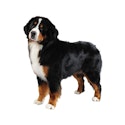Bernese Mountain Dog Breed

- Size
- Large
- Height
- Males: 25 to 27.5; Females: 23 to 26 inches
- Weight
- Males: 80 to 115 pounds; Females: 70 to 95 pounds
- Energy
- Low
- Activities
- Herding, Drafting, Carting, Conformation
Bernese Mountain Dogs, affectionately referred to as “Berners,” are a strong working breed. Their strength and size are contrasted by their calm, loving nature toward their families.
Temperament
The calm, confident Berner thrives when he’s with family. He’s affectionate toward adults and patient with children, making him an ideal family dog.
Though the Bernese Mountain Dog is not an outdoor dog, he loves going on outdoor adventures like long walks or hikes to satisfy his need for moderate daily exercise. The Berner is smart and eager to please, which can make obedience training easier.
Characteristics
As a large breed, the Bernese Mountain Dog was built to work. Though the body is sturdy, his sweet temperament is evident in his soft features, including big brown eyes.
Lifespan
7 to 10 years
Colors
Berners are easily recognized by the black, white and rust tri-color markings on their face and coat.
Shedding
The Berner’s long, thick coat protects him in cold conditions, but sheds throughout the year. A Berner will shed more heavily during the spring shedding season. Daily brushing, particularly during those seasons, will help remove the loose hair.
Health
As with other large breeds, Bernese Mountain Dogs are at risk of bloat, a life-threatening condition. Other health conditions Berners may develop include hip and elbow dysplasia, certain cancers and blood disorders. Responsible breeders screen for such health conditions.
Best Dog Food for Bernese Mountain Dogs & Puppies
Because the Bernese Mountain Dog is a large dog, he’ll benefit from a large breed dog food. Large breed formulas offer additional support for healthy joints and mobility.
A Berner puppy can also benefit from a large breed puppy food, which has all the nutrients he’ll need for healthy growth and development in his first two years of life.
History
The Bernese Mountain Dog originated on Swiss farms where he worked as a cattle drover, draft dog and guardian. Despite their hard work and gentle companionship after the workday, the Berner’s numbers were in serious decline by the end of the 19th century.
Professor Albert Heim led a Swiss breed club in 1907 in an effort to preserve the Bernese Mountain Dog. By 1926, the breed made its way to the U.S. by way of a Kansas farmer. The breed’s popularity took off and the American Kennel Club (AKC) registered their first Berner in 1937.
Facts
- The Bernese Mountain Dog is one of four varieties of Swiss mountain dogs. He’s the second largest and the only one with a long, silky coat.
- Berners can pull many times their own weight, which is why they excelled as drafting dogs.
- Roman soldiers brought the Berner’s ancestors to Switzerland over 2000 years ago.